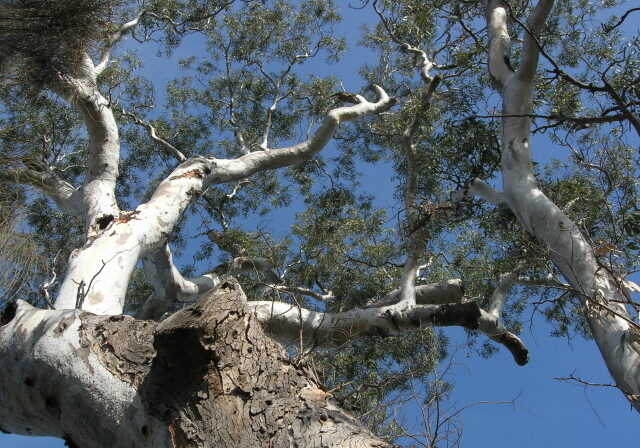Distance: Km | Duration: Hrs | Grade: TBA | Rating: | Style: One Way
About the Walk
Overview
There are hundreds of natural features registered with the National Trust in Melbourne and throughout Victoria. This walk takes us to several magnificent trees that are registered as treasured landmarks while also seeing some of inner Melbourne. The trees range from 70 to over 400 years, indigenous to exotic. This walk also takes you to many parts of inner Melbourne with many shops, cafes and restuarants along the way.
The Walk in Detail
The route for this walk can be varied to suit the people walking. Check the Historic Trees Register for more information and for other possible historic trees you may wish to visit.
The walk begins at Federation Square (Melways map 2F grid ref G5 or 27-G5) where you catch the St Kilda tram going south (away from the city) to the Junction Oval. Most trams will take you there including tram numbers 3, 5, 6, 8, 16, 64, 67, 72). Cross over St Kilda Rd to the park area (Junction Oval) where you will find the Corroboree Tree (Melways 2P-C2) near the junction of St Kilda Rd and Queens Rd. This grand River Red Gum (Eucalyptus Camldulensis) is estimated to be over 300 years old and to have witnessed countless Aboriginal ceremonies over the centuries. The curve of Queens Road was designed to skirt around the tree! The surrounding parkland has been planted with indigenous species.
Take a return tram back towards the city and get off at the Shrine of Remembrance (Melways 2G-J12) at the southern end of the Victoria Barracks complex). Walk to the Shrine and if time permits wander around the area looking at various memorials. Unfortuantely the Lone Pine tree (grown from a cone taken from Gallipoli and planted neare The Shrine) died in 2012 but therea number of other significant native and introduced trees in this area.
A short stroll takes you to Birdwood Ave which runs behind The Shrine - turn right and follow this road to Gate F into the Royal Botanical Garden (RBG). Turn right to follow the Australian Forest walk which follows the southern boundary of the park to see a magnificent Banksia Tree (Banksia Integrifolia), in existence prior to the establishment of the gardens, and possibly prior to settlement. This section of the gardens focuses on displaying a range of Australian forest species from impressive forest giants to middle and understorey trees and shrubs and features informative signage telling the story of our forest habitats. Take your time enjoying the beauty of the gardens.
Follow the path until you approach exit at Gate D. Turn left at track junction and follow the signs to the Gardens Shop and cafe overlooking the lake. Just past the shop and cafe you will find the Separation Tree, again in situ prior to Melbourne's settlement. Its significance relates to a picnic held beneath its branches when the citizens of Melbourne celebrated the separation of Victorian from NSW on 15 November 1851. A refreshment break can be taken here at the café. There is plenty to see in the Botanic Gardens if you have time to wander further - see link to the RBG map in Further Information.
Continue on this path which will take you to Gate A and Alexandera Avenue. Cross the Yarra River using the Morell Bridge (in front of you), turning left along the shared walk/cycle track that parallels the Yarra River. On reaching the Swan Street bridge cross over Swan Street and turn right. The Rod Laver Arena will now be on your left. About 200 metres along Swan Street you should see the access point to a pedestrian walkway on your left (Melways 2G - C9) - this takes past tennis courts, over tram tracks and Brunton Avenue to the 'hallowed' ground of the MCG in Yarra Park. In the late 1850s, many of the earliest games of Australian rules football were played at Yarra Park, which was known at the time as the Richmond Paddock. Make your way (anticlockwise) around to the north eastern side of the stadium and then follow a track heading north east to the site of the "Canoe tree", a River Red Gum of some 200 years. This tree is the only scarred tree still living in the park. Historic records indicate "this tree was originally the source of supply of bark used by Aborigines for canoe making."
This path brings you out at Gate 4 (Melways 2G - F5) - turn left and follow the road past Jolimont Station until you reach Wellington Road South. Turn right crossing over the railway line and then crossing Wellington Parade and over into Fitzroy Gardens. From here make your way in a generally north westerly direction which will take you diagonally across the park. This will bring you out near the corner of Clarendon and Albert Streets. Follow Albert St to the west (your left) as it becomes Lonsdale Street and continue ahead (Melways 1B-R/S2. Between Exhibition and Russell Streets you will find the site of an Olive Tree (Olea europaea ssp) in the grounds of the Wesley Church rear car park. According to legend the tree was brought to Victorian from Jerusalem in 1839 by one of the church founders, making this gnarled specimen one of the oldest exotic species in the state.
From here retrace your steps to Exhibition Street and turn left (north). Follow Exhibition Street as it corsses Victoria Parade and continue north past (or through if you have the time) the Carlton Gardens and the Exhibition Building and Museum. About 700m north of Victoria Pde turn left into Grattan Street and follow this until you reach Swanston St (approx 600km) and turn right into Swanston Street. Follow this north passing the University of Melbourne (on your left) for 750m to the large roundabout of College Corner and Keppel Avenue (Melways 2B - E4) to the site of the Lemon Scented Gums (Corymbia citriodora). Located on the roundabout at the intersection, there is no information on when the trees were planted or by whom. These elegant trees may have been planted on the instructions of Walter Burley Griffin (architect for Canberra) after the completion of Newman College.
There are many alternative routes from the Wesley Church to College Corner and you may prefer to wander along Rathdowne, Drummond or Lygon Street enjoying the shops and many cafes and restuarants in this area.
Retrace your steps south on Swanston Street until you reach the section served by trams. Take any tram down Swanston Street toward the city, to Bourke Street then catch another tram going west to the corner of King and Bourke Streets to the Chinese Honey Locus tree (Gelditsia sinensis) at 607-619 Bourke St. This tree, a native of China was supposedly planted by a Chinese immigrant in the 1850's who had come in search of gold. It is now known as the "million-dollar tree" because in the late 1980's the 19 storey office block was designed to accommodate it – hence the building is angled across the corner.
This is the end of the historic tree walk. You can continue westerly along Bourke to Southern Cross Railway Station (one block from here) to catch a train home. Alternatively catch a tram back to Swanston Street and the centre of the central city area.
Getting There
Walk starts at Information Centre, Federation Square, corner Flinders and Swanston Streets, Melbourne (opposite Flinders Street Railway Station).
Public transport is the best way to get to and from this walk. Go to the public transport victoria website to plan your journey.
Parking in the city can be difficult and expensive. There is car parking at Federation Square - entrance is off Flinders Street opposite T intersection with Russell street.
Walk Precautions
Additional Information
Federation Square 
Royal Botanic Gardens
